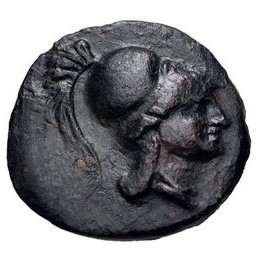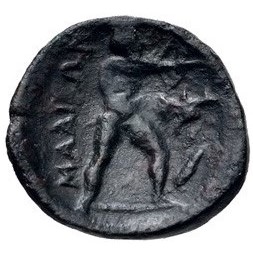Title: Chalkous of Lamia - 2018.10
Acquisition number: 2018.10
Author or editor: Peter Londey
Culture or period: Hellenistic.
Date: Late 4th century BC.
Material: Metal - Bronze
Object type: Coins - Greek
Dimensions: 14mm (w)
Origin region or location: Greece
Origin city: Lamia.
Display case or on loan: 5
Keywords: Coin, Greek, chalkous, Lamia, Malis, Malia, Athena, Philoktetes, Philoctetes, Spercheios River, Thessaly
Classical Numismatic Group, TheBCD Collection of the Coinage of Thessaly (Auction XV [3 January 2012], Lancaster PA and London, Triton, 2012), II, 125.
O. Hoover, Handbook of Greek Coinage 13 vols (Classical Numismatic Group, Lancaster, PA, 2009-2013), 4, 106 (Malia).
2018.10
Chalkous of Lamia
Bronze 1.16 g. 14 mm. late 4th century BC.
Obv.: helmeted head of Athena.
Rev.: the hero Philoktetes, with bow, shooting at birds, one of which falls before him, quiver to lower right. ΜΑΛΙΕΩΝ (‘of the Malians’).
This coin comes from the region of Malis, located in the lower valley of the Spercheios River in central Greece. The Malians were one of the twelve ethne (tribes) which were members of the Delphic Amphiktyony.
Lamia was the dominant polis in the northern part of Malis, while the Spartan foundation, Herakleia Trachinia, dominated the southern side. In the fourth century BC the two cities shared representation on the Amphiktyonic Council, but they were also rivals. This coin, minted at Lamia, could either be an expression of Malian unity or an assertion of Lamian dominance.
Athena, although particularly associated with Athens, often features on coins of other Greek cities.
Philoktetes was a legendary archer during the Trojan War. Wounded by a snake bite on the way to Troy, he was left by the Greeks on the island of Lemnos until, late in the war, they discovered that they needed him and his bow in order to win the war. Homer (Iliad 2.716–25) regards Philoktetes as the leader of the cities of Magnesia, the area around Mt Pelion east of Thessaly. But Sophokles, in his play Philoktetes, places him further south as a man of Malis. Evidently by the fourth century the Malians accepted this identification.
The term chalkous refers to a Thessalian bronze denomination, which is found in several sizes (dichalkon, trichalkon etc). These bronze issues probably replaced very small silver fractions such as the hemi-obol. While the value of Greek silver coins was based on weight, the intrinsic value of bronze coins tended to be less than face value, that is, ‘token coinage’. Consequently, tables of denominations often do not provide a conversion figure giving respective values of bronze and silver issues.
Purchased by the Friends of the ANU Classics Museum in memory of Jill Greenwell.
Classical Numismatic Group, TheBCD Collection of the Coinage of Thessaly (Auction XV [3 January 2012], Lancaster PA and London, Triton, 2012), II, 125.
O. Hoover, Handbook of Greek Coinage 13 vols (Classical Numismatic Group, Lancaster, PA, 2009-2013), 4, 106 (Malia).

